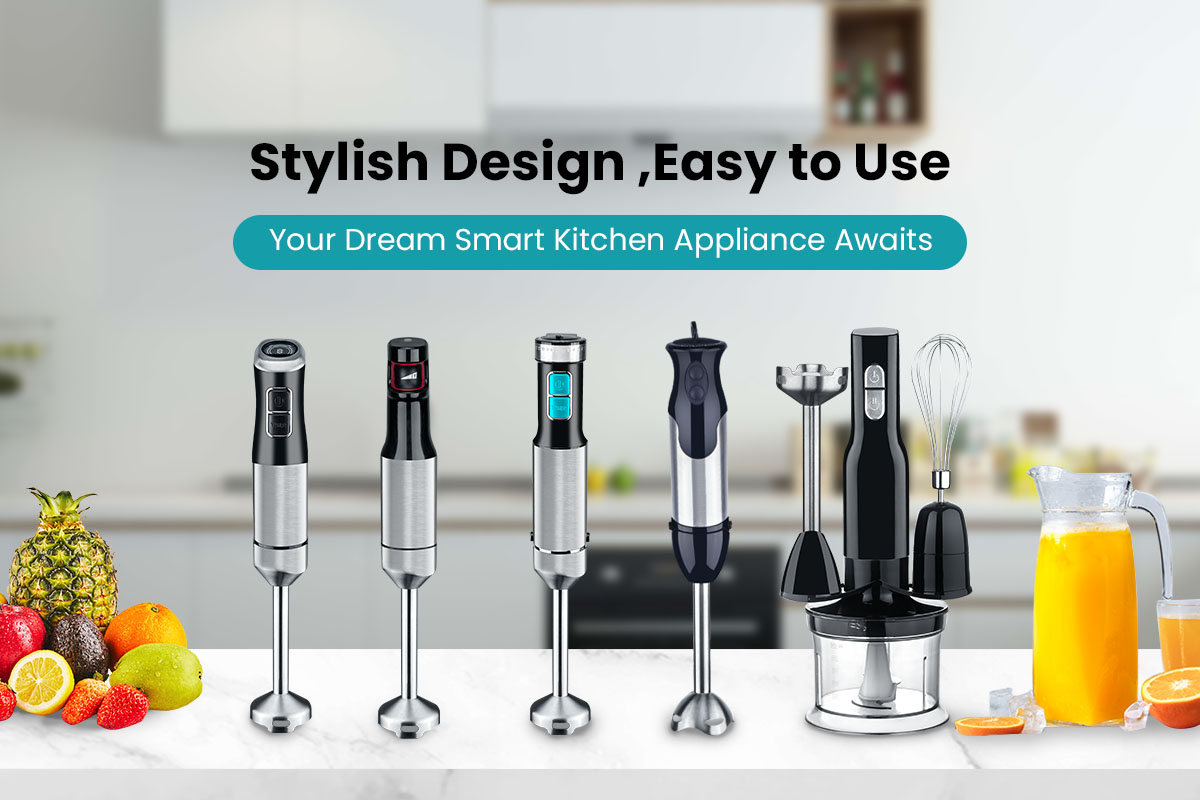Can Hand Blender Be Used In Hot Soup
Yes — a Hand Blender can absolutely be used in hot soup, and in fact, this is one of its most common and effective applications. Designed for direct immersion blending, it allows you to purée soups right in the pot — no need to transfer hot liquids to a countertop blender.
However, to use it safely and achieve the best texture, you must know the right technique, precautions, and timing. This guide explains how to blend hot soups properly using a hand blender, with professional insights from KANGJIA Electrical Appliances Co., Ltd. — a trusted manufacturer of durable and high-performance hand blenders.
1. The Short Answer
✅ Yes, you can use a hand blender in hot soup.
It’s safe and efficient — as long as your blender’s shaft is heat-resistant (preferably stainless steel) and you follow basic safety steps.
Hand blenders are built to handle hot liquids and thick textures, making them perfect for soups, sauces, and purees.
KANGJIA hand blenders are equipped with stainless steel blending shafts and anti-splash guards, specifically designed for use in hot mixtures like soups or sauces.
2. Why Use a Hand Blender for Hot Soup
Using a hand blender for soup has several advantages over a countertop blender:
| Benefit | Explanation |
|---|---|
| Safety | No risk of hot liquid explosions from blender lids |
| Convenience | Blend directly in the pot — no transferring or extra cleanup |
| Texture Control | Choose your texture: chunky or silky smooth |
| Speed | Blends large volumes of hot soup in seconds |
| Efficiency | Handles both blending and emulsifying in one step |
This makes it ideal for soups like pumpkin, tomato, carrot, or mushroom soup, where smooth consistency enhances flavor and presentation.
3. How to Blend Hot Soup Safely
Step 1: Check Material Compatibility
Ensure your hand blender has a stainless steel or heat-resistant shaft.
Avoid plastic shafts, which can warp or discolor under heat.
Step 2: Let Soup Cool Slightly (Optional)
For extra safety, let the soup sit for 1–2 minutes after boiling to reduce bubbling.
Blending immediately after boiling can cause splattering.
Step 3: Submerge the Blender Fully
Insert the blender head fully under the liquid surface before turning it on.
This prevents splashes of hot soup from escaping the pot.
Step 4: Blend in Short Bursts
Use short pulses rather than continuous blending.
Move the blender slowly up and down to create even consistency.
Step 5: Adjust Texture
Blend until the soup reaches your preferred texture — creamy or slightly chunky.
For ultra-smooth results, pass through a fine mesh sieve afterward.
KANGJIA hand blenders feature ergonomic handles and variable speed settings, giving you full control even when working with hot, dense soups.
4. Safety Tips for Blending Hot Soup
| Tip | Why It Matters |
|---|---|
| Use a deep pot | Prevents hot splatter and allows free blending motion |
| Keep blades submerged | Avoids spraying hot soup |
| Hold pot steady | Stability prevents tipping or burns |
| Wear oven mitts | Extra protection against accidental splashes |
| Turn off before lifting | Always stop the blender before removing it from soup |
Safety is crucial when blending hot foods. A KANGJIA stainless steel hand blender ensures heat resistance and easy handling to minimize risk.
5. Common Soup Types to Blend with a Hand Blender
| Soup Type | Recommended Blending Level | Notes |
|---|---|---|
| Pumpkin / Butternut Squash Soup | Fully smooth | Add cream after blending for rich texture |
| Tomato Soup | Medium-smooth | Retain slight pulp for natural flavor |
| Mushroom Soup | Smooth | Enhances depth of flavor |
| Potato Leek Soup | Silky | Ideal for creamy consistency |
| Vegetable Soup | Partial | Blend half for a thick base while keeping chunks |
The multi-speed KANGJIA hand blender allows precise texture control — from rustic to refined.
6. What to Avoid
While hand blenders are safe for hot liquids, improper handling can cause issues:
| Mistake | Problem | Solution |
|---|---|---|
| Using plastic shaft | Warping or discoloration | Use stainless steel models |
| Blending uncovered pot | Hot splashes | Always cover partially or use a deep pot |
| Blending at high speed from start | Splattering | Start on low speed, then increase gradually |
| Over-blending starchy soups (like potatoes) | Gummy texture | Use short pulses only |
Hand blenders are powerful — gentle control is key to both safety and ideal texture.
7. Cleaning After Hot Use
Unplug the blender and allow the shaft to cool for 1–2 minutes.
Detach the blending head and rinse under warm water immediately.
For sticky residues, blend a cup of warm, soapy water for 10 seconds.
Dry completely before reassembling.
KANGJIA’s detachable stainless-steel shafts make post-soup cleanup quick and effortless.
✅ Summary
| Step | Action | Key Point |
|---|---|---|
| 1 | Use stainless steel shaft | Safe for hot soups |
| 2 | Let soup cool slightly | Prevents splashes |
| 3 | Submerge before starting | Avoids burns |
| 4 | Pulse gently | Smooth texture, no bubbles |
| 5 | Clean promptly | Maintain hygiene and durability |
Final Thoughts
A hand blender is one of the safest and most efficient tools for blending hot soup directly in the pot. It saves time, reduces cleanup, and gives you full control over soup texture — from creamy to chunky.
For reliable results, use a stainless-steel, multi-speed hand blender, like those from KANGJIA Electrical Appliances Co., Ltd., built to handle high temperatures, dense ingredients, and everyday kitchen demands.
In short: Yes, you can use a hand blender in hot soup — just keep it submerged, use short bursts, and enjoy perfectly smooth, piping-hot results right from the pot.





